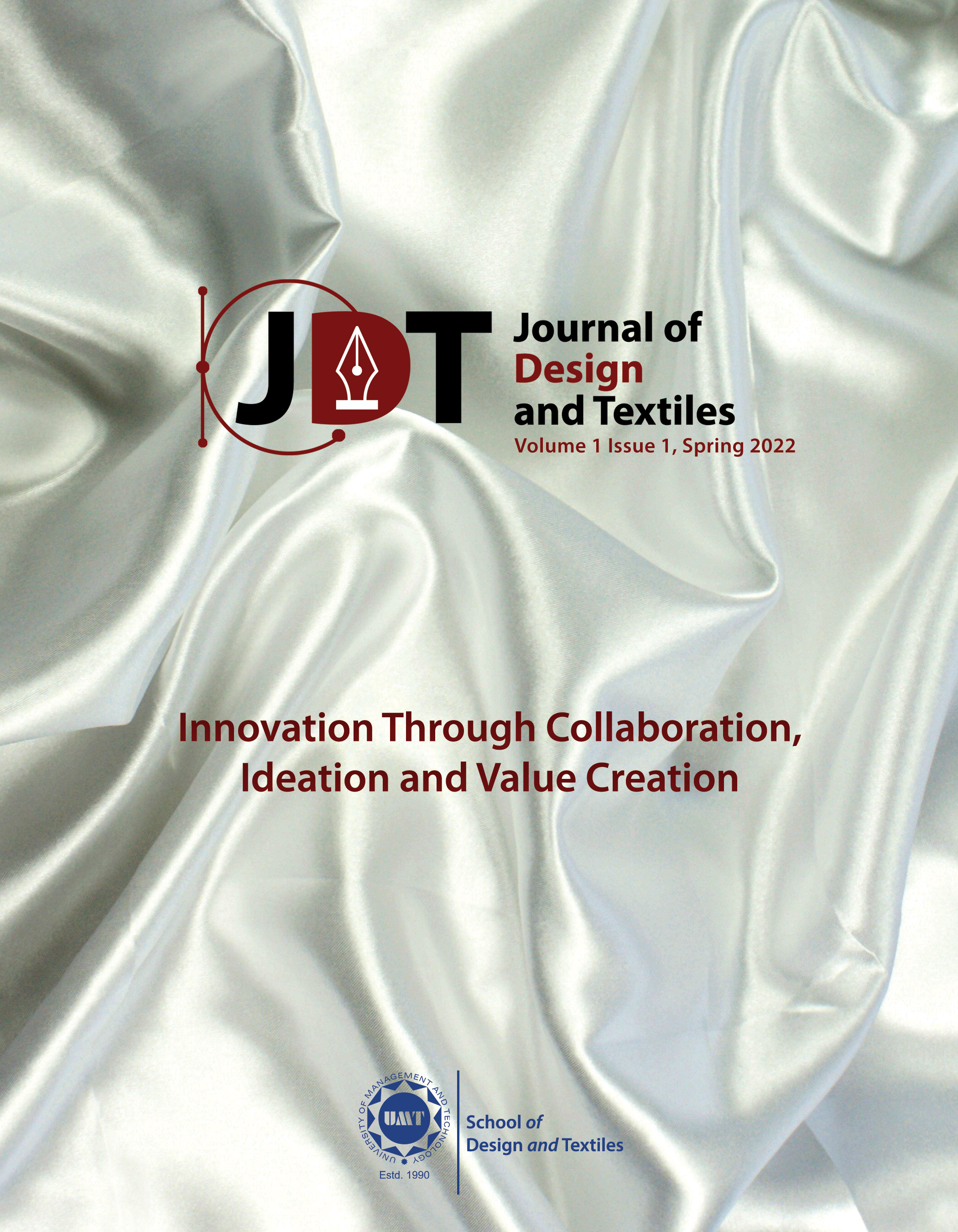Effects of Metal Ions Present in Recycled Water on Washing of Reactive Dyed Cotton Fabric
Abstract
 Abstract Views: 54
Abstract Views: 54
Textile industry is a key source of contamination of heavy metal ions in water. These heavy metal ions include lead, cadmium, copper, arsenic, nickel, chromium, zinc, and mercury. These metals have been recognized as hazardous heavy metals because of their high degree of toxicity. Initially, copper was selected to determine the effects of metals present in recycled water during the washing process because of its extensive usage in the textile industry. However, copper becomes a part of process water while manufacturing and even a part of recycled water. Furthermore, recycled water contains such traces of metal that can cause problems during its reuse. In the current research, the presence of copper ions in water was simulated with copper sulphate and the obtained water was used for washing of fabric after reactive dyeing. The effects of salt on washing of three different types of reactive dyes, that is, monochlrotriazine, dichlorotriazine and vinylsulphone were evaluated by washing of dyed fabric. Moreover, evaluation process was achieved with different concentrations of salt at different temperatures, pH values, and time intervals. Besides, K/S, fixation%, color uniformity, color change, washing fastness, and rubbing fastness of samples were measured during evaluation. Results were also compared with detergent and water wash. Eventually, the results showed that copper has a prominent effect on fabric. Hence, it would be possible to allow certain concentrations of copper during the process of washing.
Index Terms: cotton, exhaust dyeing, metal ions, reactive dye, recycled water
Downloads
References
C. Allegre, M. Maisseu, F. Charbit and P. Moulin, "Coagulation–flocculation decantation of dye house effluents: concentrated effluents." J. Hazard. Mater., vol. 116, no. 1-2, pp. 57-64, Dec. 2004, doi: https://doi.org/10.1016/j.jhazmat.2004.07.005
P. H. Gleick, Water in crisis: A guide to the world's fresh water resources. Oxford University Press, 1993.
D. Hinrichsen, B. Robey and U.D. Upadhyay, Solutions for a water-short world. Population Reports, 1998.
R. A. Corbitt, Standard handbook of environmental engineering. McGraw-Hill, 1990.
S. Tunali, A. Cabuk and T. Akar, "Removal of lead and copper ions from aqueous solutions by bacterial strain isolated from soil." Chem. Eng. J., vol. 115, pp. 203-211, Jan. 2006, doi: https://doi.org/10.1016/j.cej.2005.09.023
Manivaskam, N., Water used in textile processing-quality, treatment and analysis. Coimbatore: Sakthi Publications, 1995.
B. Smith, and J. Rucker, Water and Textile Wet Processing-Part I. Am. Dyest. Report., vol. 76, pp. 15-24, July 1987.
M. A. Shaikh, "Water conservation in textile industry." Pakistan. Text. J., pp. 48-51, Nov. 2009.
V. Prigione, G. C. Varese, L. Casieri and V. F. Marchisio, "Biosorption of simulated dyed effluents by inactivated fungal biomasses." Biores. Technol, vol. 99, no. 9, pp. 3559-3567, June. 2008, doi: https://doi.org/10.1016/j.biortech.2007.07.053
G. N. Bidhendi, A. Torabian, H. Ehsani and N. Razmkhah, "Evaluation of industrial dyeing wastewater treatment with coagulants and polyelectrolyte as a coagulant aid." J. Environ. Health. Sci. Eng., vol. 4, no. 1, pp. 29-36, 2007.
S. -F. Kang, C. -H. Liao and M. -C. Chen, "Pre-oxidation and coagulation of textile wastewater by the Fenton process." Chemosphere, vol. 46, no. 6, pp. 923-928, Feb. 2002, doi: https://doi.org/10.1016/S0045-6535(01)00159-X
S. H. Lin, and M. L. Chen, "Treatment of textile wastewater by chemical methods for reuse." Water Res., vol. 31, no. 4, pp. 868-876, Apr. 1997, doi: https://doi.org/10.1016/S0043-1354(96)00318-1
N. Tarafder, "Eco safe natural dyes & application on textile materials." Man-made Textiles India. vol. 52, no. 10, pp. 355-361, Oct. 2009.
R. Siva, "Status of natural dyes and dye-yielding plants in India." Curr. Sci., vol. 92, no. 7, pp. 916-925, Apr. 2007.
E. El-Khatib, N. Ali and M. Ramadan, "Environmentally friendly dyeing of silk fabrics using microwave heating." Int. J. Curr. Microbiol. Appl. Sci., vol. 3, no. 10, pp. 757-764, 2014.
S. Bhattacharya and A. K. Shah, "Metal ion effect on dyeing of wool fabric with catechu." Color. Technol., vol. 116, no. 1, pp. 10-12, June 2000, doi: https://doi.org/10.1111/j.1478-4408.2000.tb00002.x
I. Castelo-Branco, A. Silva and R.M. Quinta-Ferreira, "Catalysts for Wastewater Treatment," in Principles and Methods for Accelerated Catalyst Design and Testing, vol. 69, E. G. Derouane, V. Parmon, F. Lemos and F. R. Ribeiro, Eds. Springer, 2002, pp. 383-388, https://doi.org/10.1007/978-94-010-0554-8_25
J. Fan, Y. Guo, J. Wang and M. Fan, "Rapid decolorization of azo dye methyl orange in aqueous solution by nanoscale zerovalent iron particles," J. Hazard. Mater., vol. 166, no. 2-3, pp. 904-910, July 2009, doi: https://doi.org/10.1016/j.jhazmat.2008.11.091
S. Raghu, and C. A. Basha, "Chemical or electrochemical techniques, followed by ion exchange, for recycle of textile dye wastewater," J. Hazard. Mater., vol. 149, no. 2, pp. 324-330, Oct. 2007, doi: https://doi.org/10.1016/j.jhazmat.2007.03.087
G. Ciardelli, and N. Ranieri, "The treatment and reuse of wastewater in the textile industry by means of ozonation and electroflocculation," Water Res., vol. 35, no. 2, pp. 567-572, Feb. 2001, doi: https://doi.org/10.1016/S0043-1354(00)00286-4
S. A. Costa, T. Tzanov, F. Carneiro, G.M. Gübitz and A. Cavaco-Paulo, "Recycling of textile bleaching effluents for dyeing using immobilized catalase," Biotechnol. Lett., vol. 24, pp. 173-176, Feb. 2002, doi: https://doi.org/10.1023/A:1014136703369
G. Ciardelli, L. Corsi and M. Marcucci, (2001) Membrane separation for wastewater reuse in the textile industry." Resour. Conserv. Recycl., vol. 31, no. 2, pp. 189-197, doi: https://doi.org/10.1016/S0921-3449(00)00079-3
U. Rott, and R. Minke, "Overview of wastewater treatment and recycling in the textile processing industry." Water Sc. Technol., vol. 40, no. 1, pp. 137-144, 1999, doi: https://doi.org/10.1016/S0273-1223(99)00381-9
R. McDonald, Colour physics for industry. The Society of Dyers and Colourists, Bradford, 1997.
R. G. Kuehni, , Color Vision & Technology. American Association of Textile Chemists and Colorists, 2008.

This work is licensed under a Creative Commons Attribution 4.0 International License. Authors retain copyright and grant the journal right of first publication with the work simultaneously licensed under a Creative Commons Attribution (CC-BY) 4.0 License that allows others to share the work with an acknowledgement of the work’s authorship and initial publication in this journal.






